Looking for a formula for writing good SEO product descriptions in 2024? Want some tips to make your product descriptions as SEO-friendly as possible? This guide is here to help.
In this guide, we’ll walk you through the importance of making your product descriptions SEO-friendly, some tips for doing it well, and a formula you can use to write the best SEO product descriptions possible.
First, let’s take a look at why making your product descriptions search engine-ready is important.
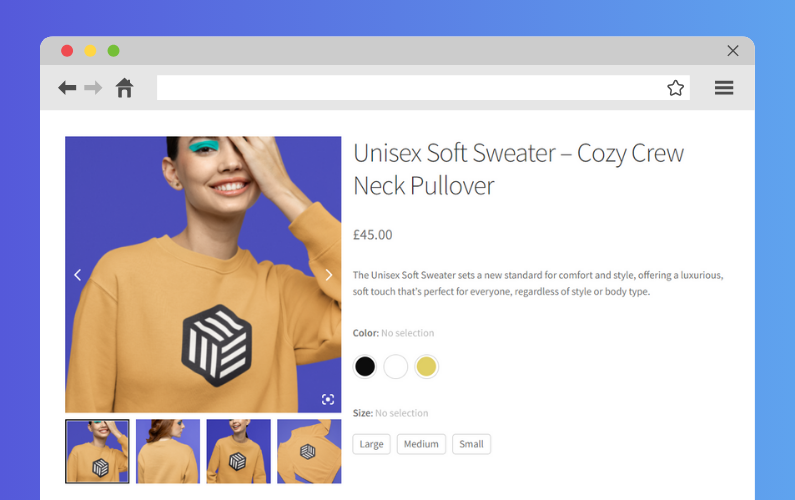
Why are SEO product descriptions important?
SEO (Search Engine Optimization) product descriptions play a crucial role in the online visibility and success of your ecommerce business.
Here’s why they are so important:
1. They improve search engine rankings
This is perhaps the most obvious benefit, but effective SEO practices in your product descriptions can help your items climb higher in search engine results pages (SERPS). This improved visibility means your products are easier to find for anyone searching online.
Incorporating relevant keywords into your product descriptions helps search engines understand your products better. This ensures that your offerings are more likely to appear in front of the people actively searching for them.

2. They increase website traffic
Including targeted keywords in your product descriptions does more than just improve SEO, it draws in more qualified organic traffic.
People using specific or long-tail keywords in Google search are often in the later stages of the buying process, actively looking to make a purchase decision on products like yours.
This targeted approach not only increases your site’s visibility but also enhances organic reach, potentially reducing reliance on paid advertising.
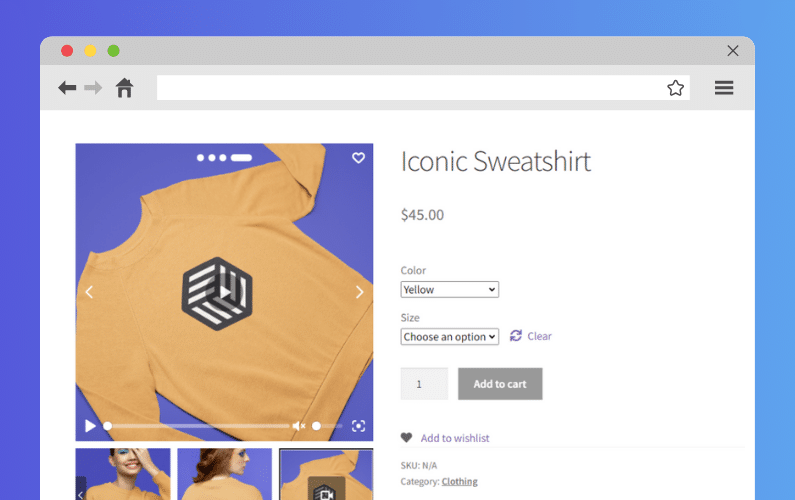
3. They enhance your ecommerce site’s user experience
On the other hand, SEO-optimized product descriptions significantly enhance the user experience.
They offer valuable information, allowing customers to make well-informed decisions.
The use of bullet points, headers, and short paragraphs in your descriptions improves readability, making it easier for customers to digest information and navigate your product pages smoothly.
4. They boost your store’s conversion rates
Engaging and keyword-rich product descriptions play a pivotal role in increasing conversion rates.
They not only capture the reader’s attention but also persuade them to take action, such as making a purchase.
Detailed and accurate descriptions foster trust, encouraging customers to buy from a website that provides clear and helpful information about its products.
5. They give you a competitive advantage
Crafting unique and optimized product descriptions gives your offerings a competitive edge.
They allow you to highlight what makes your products special, differentiating them from competitors’.
An effective SEO strategy can elevate your products in search results, outperforming competitors and capturing a larger share of the market. This strategic positioning is crucial for establishing and maintaining a strong presence in a crowded online marketplace.
So now we know why SEO product descriptions are so benefitial, let’s get into the tips.
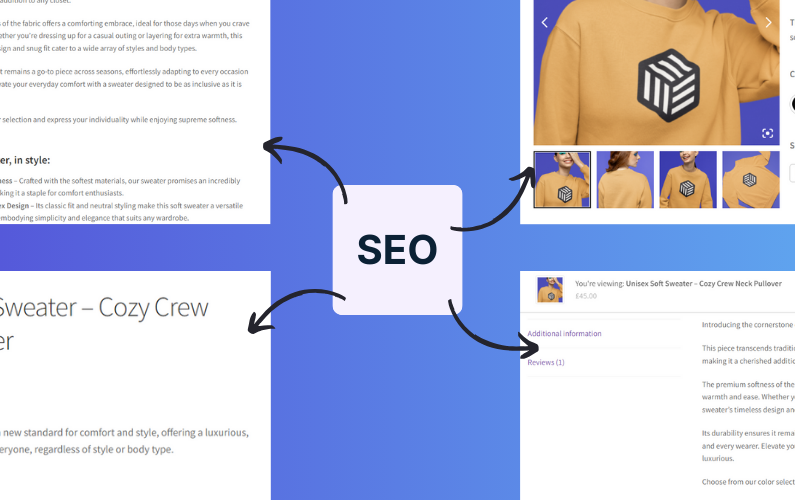
How to write good SEO product descriptions
In this section, we’ll dive into how to craft SEO-friendly product descriptions that not only catch the eye of search engines but also resonate with your potential customers.
Writing compelling product descriptions is an art that balances informative content with strategic SEO practices.
By following the steps outlined below, you’ll learn how to attract more visitors to your site and convert them into customers.

1. Understand your target audience
The first step in writing great product descriptions is to really understand who you’re writing for.
Create your customer profile
Start by creating a detailed profile of your ideal customer/searchers. Consider demographic factors like age, interests, lifestyle, and pain points in your buyer persona.
For example, if you’re selling eco-friendly yoga mats, your target audience might be environmentally conscious, health-focused individuals in the 25-45 age range.
Create a product description style guide
Now you have your target customer in mind, it’s important to put together a style guide so you can speak directly to that customer.
Establish your tone of voice
Decide on the tone and voice that best align with your audience persona.
For a younger, more casual audience, a friendly and conversational tone might be best. For a professional audience, a more formal and informative tone could be appropriate. Include examples of phrases or sentences that exemplify this tone.
Outline the vocabulary they use
Include a list of words or phrases that resonate with your target audience.
For the eco-friendly yoga mat, words like “sustainable,” “organic,” “non-toxic,” and “ethical” might appeal.
Conversely, list words to avoid that don’t fit your brand or might turn off your target audience.
Get specific on the format
Since readability is key, outline how product descriptions should be formatted. This might include using bullet points for features, short paragraphs for easier reading, and headers for sections.
Tailor these preferences to what’s most accessible for your audience.
Add in some examples
Incorporate examples of product descriptions that embody all the elements of your style guide. This gives your team concrete models to follow.
2. Do some keyword research
Next, you’ll want to find the keywords and phrases that your potential customers are using to search for products like yours.
Find relevant keywords
Use SEO tools like Google Keyword Planner or Ahrefs to uncover the search queries your potential customers use when searching for products like yours.
For the eco-friendly yoga mat, relevant keywords might include “eco-friendly yoga mat,” “sustainable yoga accessories,” and “non-toxic exercise mat.”
Make sure to take into consideration the search volume and level of competition when picking your keywords.
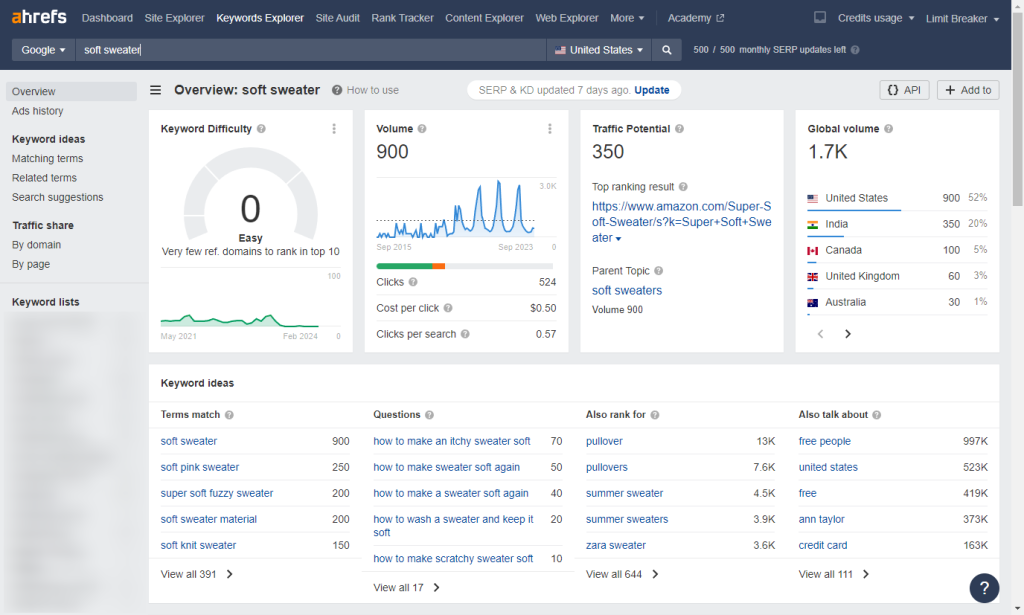
Focus on long-tail keywords
These keywords are longer phrases that are more specific and usually less competitive. For example, instead of “yoga mat,” use “biodegradable eco-friendly yoga mat.”
These keywords often have a higher conversion rate because they cater to customers who know exactly what they want.
Align with search intent
Understanding why users are searching for a product allows you to tailor your descriptions to meet their needs.
If someone is searching for “the best eco-friendly yoga mat for beginners,” they are likely looking for detailed information on why your product is suitable for beginners.
Your description should then highlight features like durability, grip, and ease of use for beginners.
3. Write descriptive titles
Creating the perfect title for your product involves a strategic blend of SEO and customer engagement tactics.
Begin by placing your most important keyword towards the start of the title to catch both the search engine’s and the customer’s attention right away.
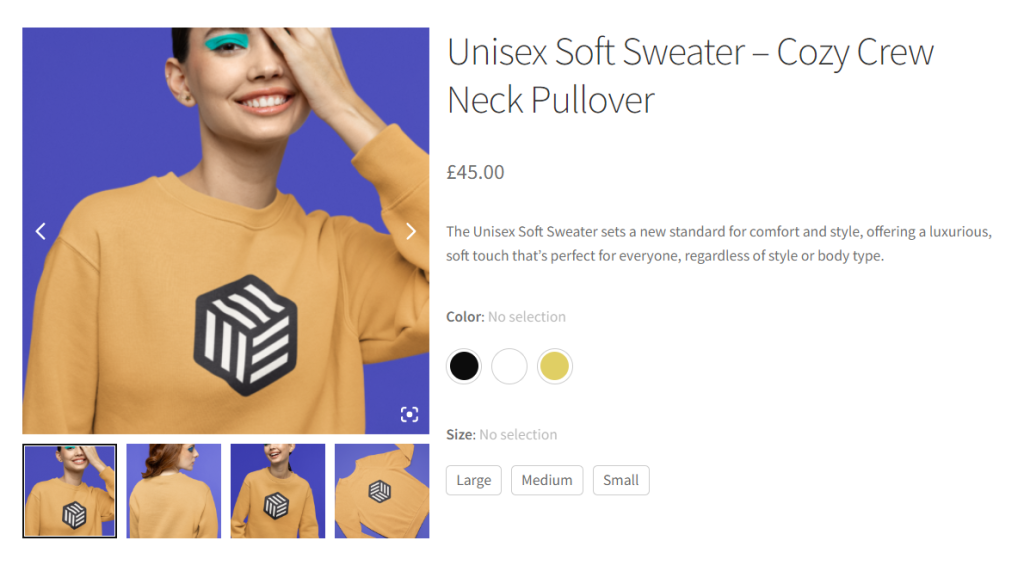
For instance, if you’re selling an eco-friendly yoga mat, a title like “Eco-Friendly Yoga Mat: Non-Slip, Durable, and Sustainable” incorporates the primary keyword while also highlighting key features.
Remember, your title should be a mini-advertisement for your product, summarizing its essence in under 60 characters. This ensures it’s displayed fully in search results, capturing interest with precise, descriptive language.
4. Create compelling meta descriptions
Meta descriptions serve as the 160-character pitch for your product, appearing under your page title in search results.
They should encapsulate the core benefits and unique selling points of your product, incorporating primary keywords in a way that feels natural and conversational.
For example, “Discover our eco-friendly yoga mat that combines grip with sustainability. Perfect for every pose, it’s your ideal workout partner.”
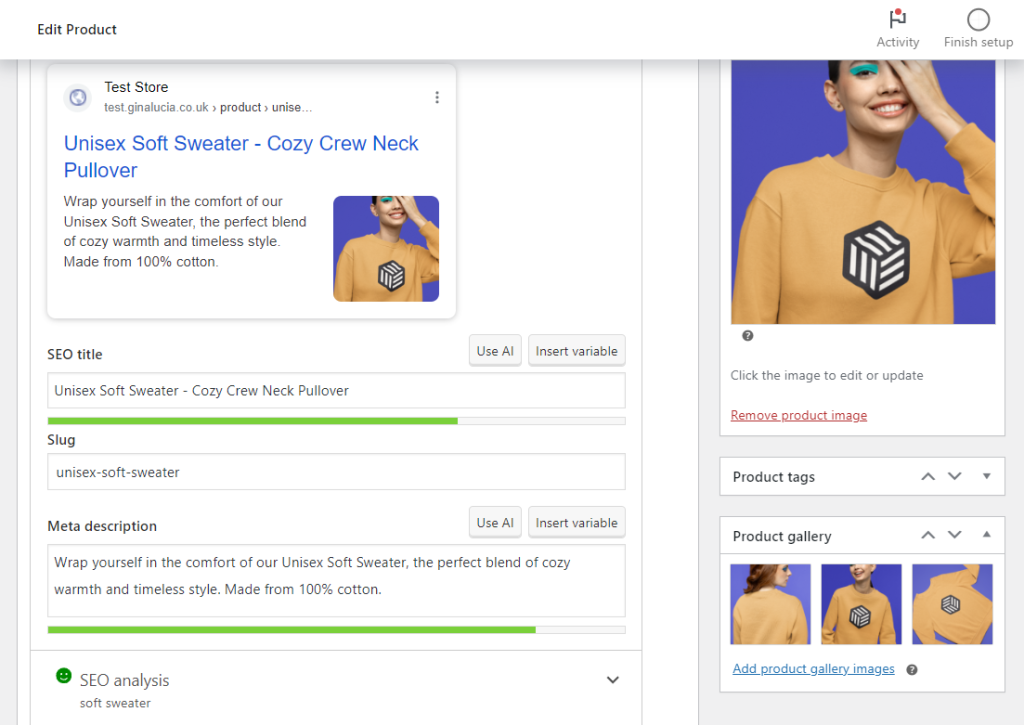
This kind of description uses active language to entice clicks, suggesting the product fulfills a need or solves a problem.
Given the rise of voice search, phrase your descriptions in a way someone might speak them. Think about how people ask questions or describe what they’re searching for to their voice assistants and mirror that conversational tone.
5. Use bullet points for key features
Bullet points allow you to break down the product’s benefits and features in an easily digestible format. Start each point with a benefit, followed by the feature that provides it.
For example:
- Sustainably made: Crafted from 100% organic materials, our yoga mat supports both your practice and the planet.
- Superior grip: Enjoy unmatched stability in your poses thanks to our specially designed non-slip surface.
This structure not only highlights the product’s advantages but also integrates relevant keywords smoothly, enhancing SEO without compromising on readability.
Keep your bullet points concise and focused on what matters most to your target audience.

6. Provide detailed product descriptions
A well-crafted product description tells a story that resonates with the reader, providing them with all the information they need while also convincing them of the product’s value.
Detail the product’s journey from conception to creation, emphasizing how it addresses specific customer needs or desires.
Include technical details and specs like dimensions, care instructions, or material origins in a way that adds to the narrative rather than detracting from it. We don’t want the manufacturer description here, we want something that adds value.
For example, rather than simply stating the dimensions of the yoga mat, you could explain how its extra length and cushioning provide ample space and comfort for any practice.
Don’t worry too much about the description length. It can be long, as long as you’re not keyword stuffing or making it long for the sake of it.
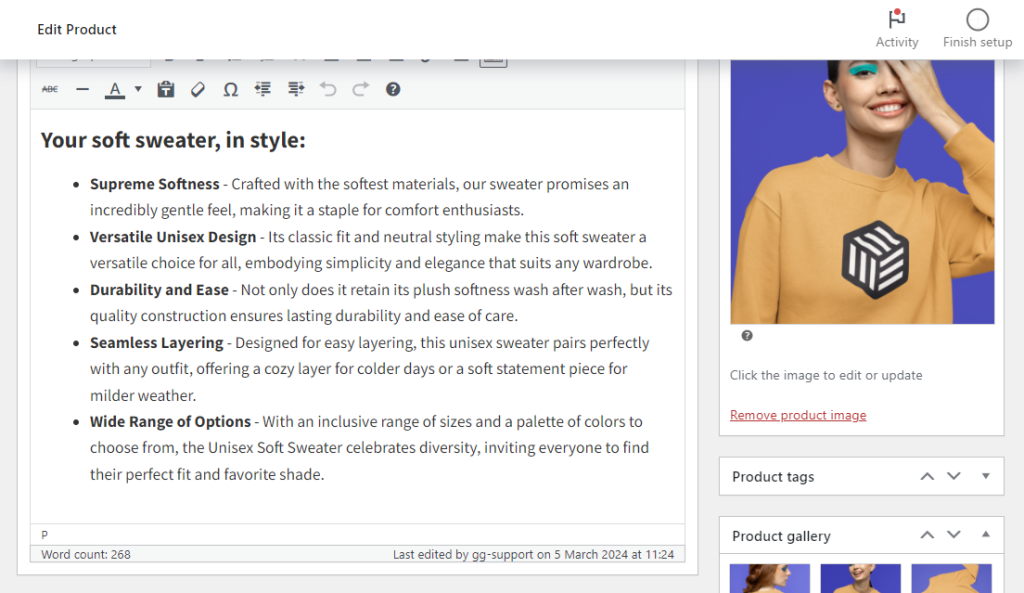
7. Optimize for readability
When writing product descriptions, the layout and structure of your product descriptions can significantly impact their effectiveness.
Use short paragraphs to introduce different aspects of the product, ensuring each section is easy to read and understand.
Headers can guide the reader through your description, separating sections like benefits, specifications, and reviews.
For instance, under a “Why You’ll Love It” header, you could list personal or emotional benefits that connect with the reader, followed by a “Specifications” header for the technical details.
This not only improves readability but also helps with SEO by incorporating relevant keywords throughout the headers and text.
Social proof, such as customer testimonials or review highlights, can be seamlessly integrated into your product descriptions or displayed prominently on your product page.
For example, you could include a quote from a satisfied customer saying, “This is the best yoga mat I’ve ever used; its grip and eco-friendly design have transformed my practice!”
Including a rating system or badges like “Best Seller” or “Customer Favorite” also leverages social proof to build trust and encourage purchases.
Ensure this content is updated regularly to reflect the most current and relevant customer experiences.
9. Optimize with images and videos
Optimizing the visuals on your product pages goes beyond just making them look good.
Add ALT text to all product images
Start with alt text for your product images, which should describe what’s in the picture while incorporating relevant keywords.
This not only aids in SEO by giving search engines more content to index but also improves accessibility for users who rely on screen readers.
Add video to your product gallery
Product videos can significantly boost engagement by providing a more detailed look at your product in action, demonstrating its value in a way that images and text alone cannot.
When it comes to videos, consider using a tool like WooThumbs for WooCommerce to enhance the user experience on your product pages.

WooThumbs allows you to add multiple, zoomable images and videos to your product galleries in WooCommerce, offering a dynamic way to showcase your products.
The visual quality of your images and videos plays a huge role in user experience and can influence conversion rates.
High-quality, well-optimized visuals not only captivate your audience but also keep them engaged longer, potentially reducing bounce rates and improving your site’s SEO.
WooThumbs for WooCommerce
Enable zoom, sliders, video, fullscreen, multiple images per variation, and customisable layout options for your product imagery.
10. Update your product descriptions regularly
Regular updates ensure that your content remains relevant, reflects the latest trends, and incorporates new keywords that your audience is searching for.
This could mean updating your descriptions to highlight new features, address seasonal trends, or incorporate new SEO strategies.
Keeping your content fresh not only helps maintain high rankings in search results but also keeps your audience engaged with the most current and relevant information. This is key when writing good product descriptions.
11. Leverage user-generated content
User-generated content, like customer reviews and Q&A sections, can be a goldmine for SEO.
Encouraging your customers to leave reviews and answer questions not only provides social proof to prospective buyers but also enriches your content with a diverse range of keywords.
This natural variation can help your pages rank for long-tail keywords and phrases you might not have thought to target. Plus, fresh, regularly updated content is a positive signal to search engines, indicating that your site is active and relevant.
Implementing features that facilitate user interaction and content generation can significantly enhance your SEO efforts and product page performance.
12. Use schema markup
Implementing schema markup on your product pages is like giving search engines a cheat sheet about your content.
This structured data format makes it easier for search engines to understand the specifics of your products, such as price, availability, reviews, and more.
By providing this detailed information in a format they prefer, you’re more likely to enhance your visibility in search results, including the possibility of appearing in rich snippets and other specialized search features.
What is schema markup?
Schema markup is developed and supported by major search engines like Google, Bing, Yahoo, and Yandex as a common set of vocabularies for structured data markup on web pages.
It’s implemented using JSON-LD (JavaScript Object Notation for Linked Data), Microdata, or RDFa formats. JSON-LD is the most recommended format by Google due to its ease of implementation and separation from the page’s content.
How to add schema markup to your product pages
- Identify the schema types needed: Determine which types of schema markup are relevant to your product pages. For an ecommerce site, relevant schemas might include
Product,Offer,AggregateRating, andReview. - Generate the markup: Use a tool like Google’s Structured Data Markup Helper to generate the schema markup for your product pages. You’ll select the type of data (e.g., a product), paste in the URL of the page or the HTML, and start tagging the elements of your page (like name, price, and review) according to the schema types.
- Add the markup to your site: Once you’ve generated the schema markup, you need to add it to your website’s HTML. If you’re using JSON-LD (recommended), you can insert the script in the
<head>section of your product page HTML or use a CMS plugin that makes this process easier. For WordPress users, several SEO plugins and WooCommerce extensions facilitate the integration of schema markup without needing to directly edit the HTML. - Test it: After adding the schema markup to your pages, use Google’s Rich Results Test tool to verify that Google can correctly parse and display your structured data. This tool will highlight any errors or suggestions for improving your markup.
Schema markup can significantly boost click-through rates by providing potential customers with valuable information directly in the search results, making it a powerful tool for improving SEO and user experience.
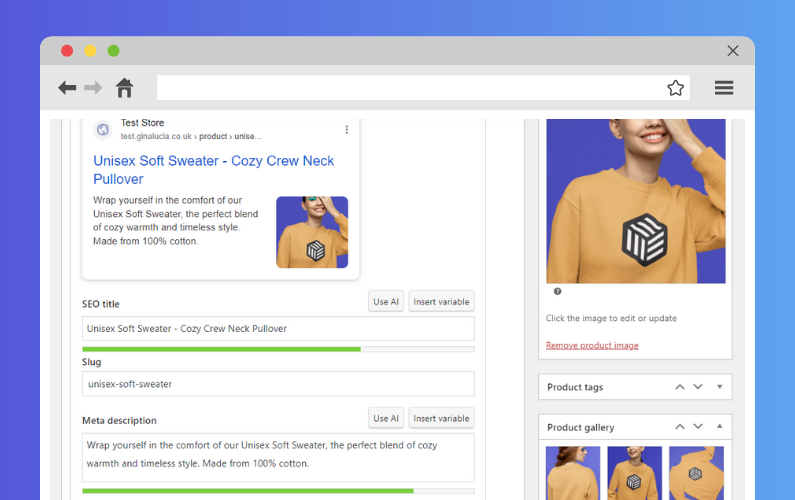
A formula for writing the best product description
With all of the tips in this article in mind, let’s outline a formula you can use to write the best possible SEO product description for your ecommerce website.
Our SEO-friendly product description template
Product title
- Formula: [Primary Target Keyword] – [Specific Product Name] | [Unique Selling Proposition/Secondary Keyword]
- Example: Eco-Friendly Yoga Mat – Non-Slip & Durable | Made with Natural Rubber
Meta description
- Formula: [Enticing Summary with Primary Keyword] + [Call to Action/CTA] + [Unique Feature/Secondary Keyword].
- Example: Discover our Eco-Friendly Yoga Mat, perfect for enhancing your yoga practice with its non-slip surface. Shop now for sustainability meets performance!
Introduction sentence
- Formula: [Product Name] is [Primary Keyword] that [Benefit].
- Example: Our Eco-Friendly Yoga Mat is a game-changer for environmentally conscious yogis seeking unmatched grip and comfort.
Bullet points for key product features
- Formula: [Feature] – [Benefit] + [How It Solves a Problem or Meets a Need].
- Example:
- Sustainable Material – Made with 100% natural rubber, ensuring your practice is kind to the planet.
- Superior Grip – Designed to prevent slips and slides, enabling you to hold poses longer and with confidence.
- Extra Cushioning – Provides added comfort to protect your joints during intense or extended sessions.
Detailed product description
- Formula: Begin with [Narrative/Story] about the [Product’s Journey/Inspiration]. Follow with [Detailed Specifications] and [Use Cases/Scenarios].
- Example: Inspired by the Earth’s natural beauty, our Eco-Friendly Yoga Mat was created to blend functionality with sustainability. Crafted from high-quality, biodegradable materials, this mat offers exceptional durability and grip, making it ideal for both beginners and seasoned yogis alike. Whether you’re practicing in the studio or meditating in the great outdoors, our mat supports your every move while protecting the planet.
Social proof
- Formula: [Highlight Customer Review/Testimonial] + [Call to Action].
- Example: “The best yoga mat I’ve ever owned! Not only does it help me stay aligned with my eco-friendly values, but its grip and comfort are unparalleled.” – Happy Customer. Experience the difference for yourself—shop now!
Call to action
- Formula: [Action Verb] + [Product Name] + [Benefit/Outcome].
- Example: Elevate your yoga practice with our Eco-Friendly Yoga Mat. Achieve balance and harmony in an eco-conscious way. Shop now!
Improve your SEO product descriptions today
So there we have it, the ultimate guide to writing the best SEO product descriptions for your online store.
With the tips in this guide, you’ll be able to use our formula to find the right keywords and craft unique product descriptions that not only rank you higher, but get results too.
WooThumbs for WooCommerce
Enable zoom, sliders, video, fullscreen, multiple images per variation, and customisable layout options for your product imagery.

